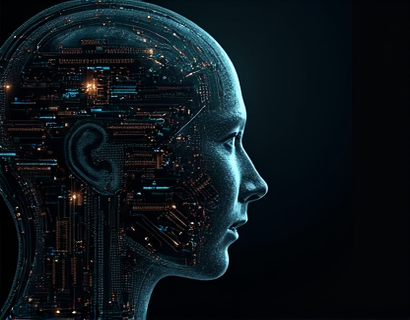Revolutionizing User Engagement: The Synergy of Crypto and AI in the Digital Age
The intersection of cryptocurrency and artificial intelligence (AI) is ushering in a new era of digital innovation, fundamentally transforming how users interact with apps and digital services. This fusion leverages the unique strengths of both technologies to create advanced solutions that enhance user experiences, drive growth, and foster meaningful connections in the rapidly evolving tech landscape. As tech-savvy individuals and professionals delve deeper into the realms of crypto and AI, understanding the latest advancements and their applications becomes crucial for staying ahead in this dynamic field.
Enhanced Security through Cryptographic Techniques
One of the primary ways crypto technology enhances user engagement is through robust security measures. Cryptographic techniques ensure that user data is protected against unauthorized access and breaches, building trust and confidence in digital platforms. Blockchain, the underlying technology of cryptocurrencies, provides a decentralized and immutable ledger that records transactions transparently and securely. This not only safeguards user information but also reduces the risk of fraud and cyber attacks, making digital interactions more secure and reliable.
Moreover, the use of cryptographic signatures and tokens can streamline authentication processes, allowing users to verify their identities quickly and efficiently. This seamless verification enhances the overall user experience by reducing friction and improving access control. For instance, decentralized identity solutions leverage blockchain to give users full control over their personal data, enabling them to share information selectively and securely with apps and services they trust.
Personalized User Experiences through AI
AI plays a pivotal role in creating personalized user experiences by analyzing vast amounts of data to understand individual preferences and behaviors. Machine learning algorithms can process user interactions, feedback, and historical data to predict and tailor content, recommendations, and functionalities that resonate with each user. This level of personalization not only increases user satisfaction but also boosts engagement and retention rates.
For example, AI-driven content curation can dynamically adjust the type and timing of notifications, ensuring that users receive relevant and timely information. Personalized interfaces and user journeys can adapt to individual habits and preferences, making the app experience more intuitive and user-friendly. By leveraging natural language processing (NLP), AI can also enable more natural and effective communication between users and apps, enhancing the overall interaction quality.
Fraud Detection and Prevention
Fraud remains a significant concern in the digital space, and the combination of crypto and AI offers powerful tools to combat this issue. AI algorithms can analyze transaction patterns and user behavior in real-time to detect anomalies and potential fraudulent activities. By identifying suspicious patterns and flagging them for review, these systems can prevent financial losses and protect user assets.
Moreover, the transparency and traceability of blockchain technology complement AI's fraud detection capabilities. Every transaction on a blockchain is recorded and verified, providing an auditable trail that can be analyzed by AI systems. This synergy ensures that any attempt to manipulate or alter transaction data is immediately detectable, further enhancing the security and trustworthiness of digital platforms.
Decentralized Applications and User Empowerment
Decentralized applications (dApps) powered by blockchain technology empower users by giving them greater control over their data and interactions. Unlike traditional centralized apps, dApps operate on a distributed network, eliminating the need for intermediaries and reducing the risk of data misuse. Users can interact with these apps while maintaining ownership and privacy of their information.
AI enhances the functionality of dApps by providing intelligent and adaptive features. For instance, AI can optimize resource allocation, improve user interface design, and enhance the overall performance of dApps. Smart contracts, which are self-executing contracts with the terms directly written into code, can be further augmented by AI to automate complex processes and ensure compliance with predefined rules.
Enhanced User Onboarding and Retention
The initial user onboarding process is critical for setting the tone of the user experience. AI-driven chatbots and virtual assistants can guide new users through the setup and familiarization process, answering queries and providing personalized assistance. These AI-powered tools can adapt to user needs, offering tailored support that enhances the onboarding experience and increases the likelihood of user retention.
Additionally, AI can analyze user behavior and engagement metrics to identify at-risk users and proactively implement strategies to retain them. By understanding the factors that contribute to user churn, platforms can make data-driven decisions to improve their services and keep users engaged over the long term.
Incentivization through Cryptocurrency Rewards
Cryptocurrency rewards can serve as a powerful motivator for user engagement. By integrating token-based incentive systems, platforms can encourage users to participate actively and contribute value. For example, users can earn tokens for completing tasks, providing feedback, or referring new users. These tokens can be redeemed for various rewards, such as premium features, discounts, or access to exclusive content.
AI can optimize these incentive systems by analyzing user behavior and adjusting reward structures in real-time to maximize engagement. By understanding what motivates different user segments, platforms can design more effective incentivization strategies that drive higher levels of participation and loyalty.
Predictive Analytics and User Insights
AI-driven predictive analytics can provide deep insights into user behavior and market trends, enabling platforms to make informed decisions and stay ahead of the competition. By analyzing historical data and real-time metrics, AI algorithms can forecast user actions, preferences, and potential churn points. This foresight allows for proactive measures to enhance user satisfaction and retention.
For instance, predictive models can identify which features or content are most likely to engage users, guiding content creation and feature development efforts. AI can also help in segmenting users based on their behavior and demographics, allowing for targeted marketing and personalized experiences that resonate more effectively.
Building Trust through Transparency
Transparency is a cornerstone of trust in the digital age, and the combination of crypto and AI can significantly enhance transparency in user interactions. Blockchain's immutable and transparent nature ensures that all transactions and interactions are recorded and verifiable. This transparency builds trust among users, as they can see exactly how their data is used and how the platform operates.
AI can further bolster transparency by providing clear and understandable explanations of complex processes and algorithms. Through explainable AI (XAI), users can gain insights into how decisions are made and how their data is utilized. This level of transparency not only builds trust but also empowers users to make informed choices about their digital interactions.
Conclusion
The fusion of cryptocurrency and AI is revolutionizing user engagement in the digital age, offering advanced solutions that enhance security, personalization, and trust. By leveraging the strengths of both technologies, platforms can create more secure, personalized, and engaging experiences that drive growth and foster meaningful connections. As the tech landscape continues to evolve, embracing these innovations will be essential for staying competitive and relevant in the eyes of tech-savvy users and professionals.











































